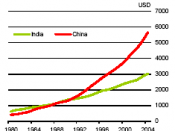Beata Jabà Âoà Âska à »Ã³à Âwin, 22.04.2007
'Comparison of development strategies in China and India'
1. Introduction
The media, financial press, are all talking about the rise of China and India in the international economy. China and India together constitute more than one-third of the world's population, both had similar development strategies prior to breaking out their insulation from the world economy and ushering from market-oriented economic reforms and liberalization. Over the last five decades, China and India have made dramatic improvements in their standard of living, structural transformation of the economy and development of the secondary and tertiary sectors. China began reformed its closed, central planned economy in 1978, while India started piecemeal reforms in 1980. The political environment under which reforms were initiated and implemented in the two countries and the consequences of them were very different. India continues to be open, participatory, multiparty democracy, while China has an authoritarian, one party regime, though it is liberalizing.
Journalist had referred to their economic reforms and integration into the world economy in all kind colorful metaphors: 'Giants shaking off their socialist slumber', 'Caged tigers', and so on. Decades ago, India was mentioned together with China as two giants, whose rise would shake the global economy. But the forecast has been only half true so far. While there is no doubt about great potential of these two economies in the rest of this century, several institutional and structural problems will hobble them for years to come. But there's such a long way to go. Millions of Chinese and Indian peasants remain poor--and resent the city folk who are benefiting from supercharged economic growth. Both countries have a multi-million strong Diaspora with the potential to assist in the countries' development, the Chinese Diaspora with capital and business know-how, and the Indian with education,


